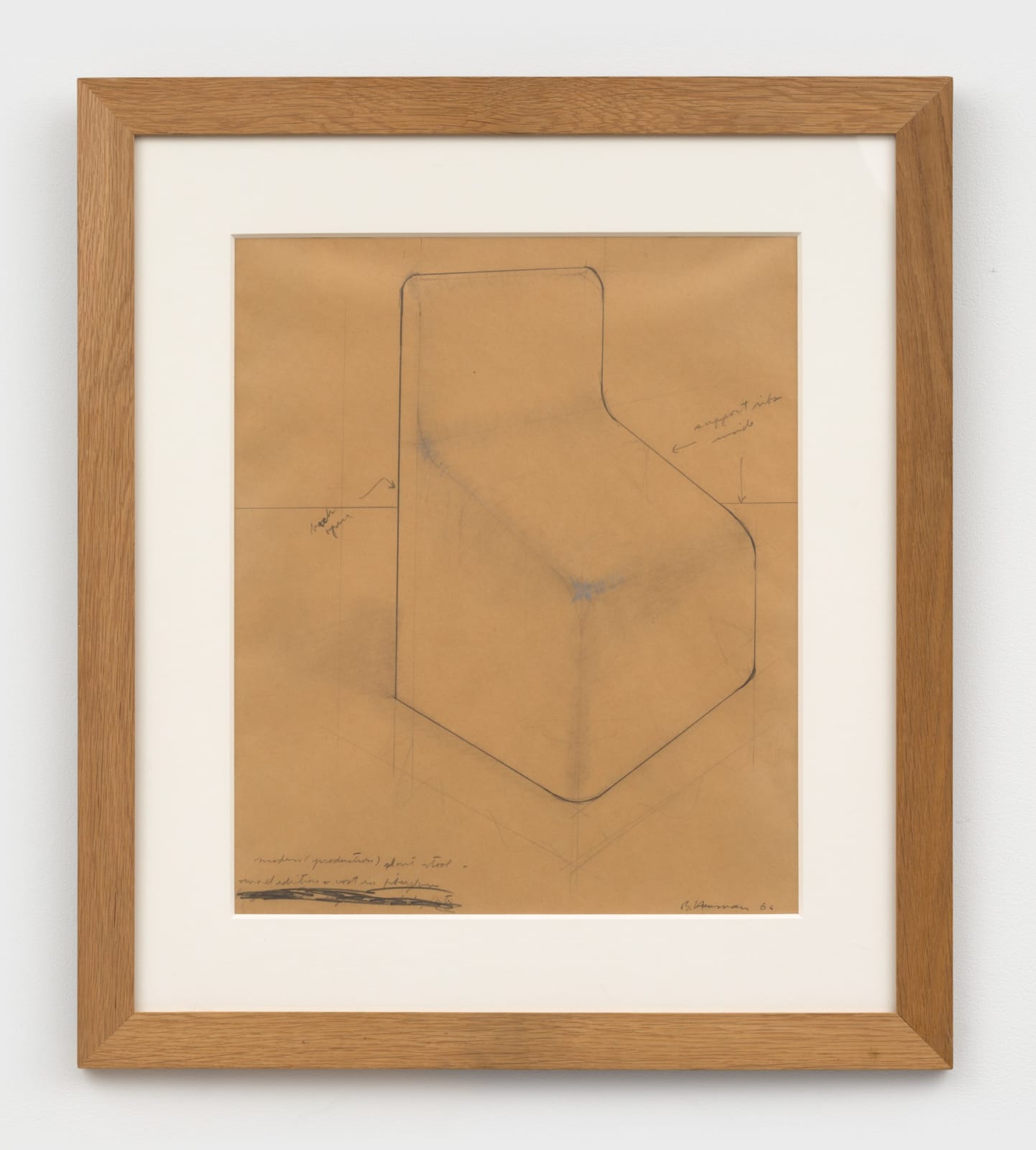-
Artworks

Bruce Nauman
Modern (Production) Slant Stool, 1966graphite on papersheet: 20 x 16 in (50.8 x 40.6 cm)
framed: 27 x 24 in (68.6 x 61 cm)'I work in that way a lot, where there are drawings, and then the work, and then more drawings to figure out what I’ve done...' Bruce Nauman Used to both..."I work in that way a lot, where there are drawings, and then the work, and then more drawings to figure out what I’ve done..." Bruce Nauman
Used to both reconcile and construct his sculptural, performative and installation pieces, Bruce Nauman’s drawings offer a unique look at the evolution of his creative process, one which continues today. As Robert Storr wrote on the occasion of an exhibition of Nauman’s work in 2002, “one should linger over the drawings. Patient concentration will be rewarded with the realization that Nauman, constant experimenter and eager pioneer of new media, is also a master of the most fundamental means of representation” (Robert Storr, "Bruce Nauman: Neons, Sculptures and Drawings," exh. cat., Van de Weghe Fine Art, New York, 2002, p. 16).
Neither utilitarian nor esthetic, the enigmatic object with an ambiguously angled form known as the “Slant Step” inspired thematic shows based on its shape or use. An object too low to function as a step, too slanted to serve as a seat, yet with a backboard as on a chair, its intended purpose remains a mystery. Not simply nonfunctional but anti-functional, its contradictions appealed to the adversative avant-garde. Moreover, its identification was perversely open-ended enough for it to act as a catalyst for the mood of flamboyant experimentation prevalent in the late ’60s. With its beat-up plywood structure covered by peeling, streaked green linoleum, the rustic object became a perfect talisman for the locals who would later be termed progenitors of “dude-ranch dada.” And with its innate equivocality, it didn’t even have to be turned upside down to convolute its meaning and reiterate Duchamp’s stance that anything can be taken out of context and become a work of art if the artist says so.
In 1965, as a graduate student at University of California, Davis, Nauman and his teacher William T. Wiley came across the “Slant Step," a seemingly ordinary step stool at the Mount Carmel Salvage Shop in Mill Valley. Together with Wiley, Nauman studied the peculiar object, which in turn influenced drawings and a plaster sculpture dedicated to the mysterious "Slant Step." His 1966 sculpture titled "Mold for a Modernized Slant Step" was a central work in an exhibition titled "The Slant Step Show," which took place the same year at the Berkeley Gallery in San Francisco, organized by poet and playwright William Witherup. Nauman’s sculpture, intended as a model cast for an edition, but instead left alone as a finished piece, is now housed in the permanent collection of the Museum of Contemporary Art, Chicago, while the original green rubber and linoleum "Slant Step" was donated to UC Davis’s permanent art collection in 2012.
The drawing "Modern (Production) Slant Stool," executed in the same year as Nauman’s plaster "Mold for a Modernized Slant Step," explores the peculiar object’s form. Notations around the work offer an intimate look at Nauman’s reflections on its structure in his attempts to reconstruct the three-dimensional form on a two-dimensional surface. The artist’s hand is evident in the ghostly, erased graphite lines beneath the outer contour of the stool, and also in the annotations surrounding the sketch, with crossed-out inscriptions and descriptive arrows. The early part of the artist’s career to which this drawing belongs marked a pivotal point in Nauman’s development as a conceptual artist. After giving up painting in the early 1960s, his studies at UC Davis transformed his work from figurative abstraction to a multi-disciplinary approach to post-modern sculpture and installation, and Nauman’s earliest drawings, like the present work, offer the most intimate look at the artist’s evolving practice.
Indeed, Nauman has relied on the medium of drawing throughout his entire career, providing the foundation for his most complex works. He often goes back and forth between preparatory diagrams to finished blueprint-like drawings. As he has stated, “Yes, I work in that way a lot, where there are drawings, and then the work, and then more drawings to figure out what I’ve done, to help me resolve what I’m in as opposed to what I thought I was doing when I got started” (Bruce Nauman, quoted in Ingrid Schaffner, "Circling Oblivion/Bruce Nauman through Samuel Beckett," Baltimore, 2002, p. 164).
MAILING LIST SIGN-UP
By completing this form, you confirm that you would like to subscribe to DAVID NOLAN’s mailing list and receive information about exhibitions and upcoming events. Your email address will be used exclusively for the mailing list service.
* denotes required fields
We will process the personal data you have supplied to communicate with you in accordance with our Privacy Policy. You can unsubscribe or change your preferences at any time by clicking the link in our emails.

